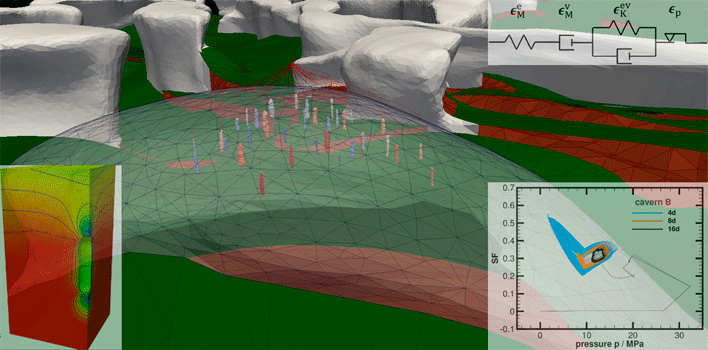H2-UGS

Project title: Begleitforschung zur Eignung von Salzkavernen-Untergrundgasspeichern zur geologischen Speicherung von Wasserstoff aus fluktuierenden, regenerativen Quellen – Teilprojekt: Modellierung der geomechanischen Integrität sowie Untersuchung von Struktur und Funktion H2-verwertender mikrobieller Gemeinschaften
(Project title – English translation: Accompanying research on the suitability of salt cavern underground gas storage facilities for the geological storage of hydrogen from fluctuating regenerative sources – Subproject: Modelling of geomechanical integrity and investigation of structure and function of H2-exploiting microbial communities)
Short project description:
One of the cornerstones of a supply-secure energy infrastructure with predominantly regenerative sources is the large-volume, safe and efficient storage of "green hydrogen" in underground gas storage facilities (UGS). One option is large-scale hydrogen storage, which has been little researched and has few pilot projects worldwide. Currently, salt caverns provide the best option to meet the requirements for operating hydrogen storage from highly fluctuating processes such as power-to-gas. The aim of the project is to develop standardised, holistic procedures for retrofitting existing cavern UGS for natural gas and to test the suitability of new storage locations for hydrogen storage. These procedures also include verification and monitoring techniques for various stages of cavern and equipment design. The results form the basis for cost-effective system design and optimal operation. The main objective of the project is the creation of conditions for pilot projects and large-scale industrial projects for the conversion of existing natural gas cavern storage facilities and the construction of new cavern storage facilities. Within this context, the geological, technical, and safety-related suitability for safe and efficient hydrogen storage using the example of a salt cavern located in central German shall be presented.
As part of the planned project work, at the UFZ and the TUBAF the work in H2-UGS will focus on the modelling and simulation of potential storage material infiltration and hydrogen permeation at the cavern contour. Determining the hydrogen infiltration in the cavern walls serves to analyse the influence of this physical process on the mechanical properties of the salt in order to be able to carry out the long-term stability test physically. The aim of the studies is to contribute to the assessment and forecasting of the cyclic operation of hydrogen caverns in salt veins and the effects on storage material and host rock. Within this context, numerical methods for the analysis of large-scale, geological hydrogen storage in salt caverns will be developed and implemented in the open-source software platform OpenGeoSys. Based on thermal-hydraulic-mechanically coupled models, the effects of cyclic processes during operation of the systems will be analysed. Scenario simulations focus on the evolution of local stress fields, on temperature field development studies, on the analysis of cavern convergence, and on the integrity of the saline barrier.
Important project results are contributions to a guideline for the definition of standardised, holistic procedures for the modification of existing caverns for hydrogen storage and for the suitability testing of new sites for the construction of hydrogen caverns. These contributions primarily include the description of geomechanical monitoring methods for the construction and operation of salt caverns for the large-scale storage of hydrogen under the main aspects of storage integrity and minimisation of environmental impacts of storage operations. On the basis of the knowledge gained, a methodology will be developed for the approval issues of the storage integrity of hydrogen caverns. The project is to be considered as accompanying research whose results are to be validated in the course of the construction and operation of a research cavern.
Project duration: 09/18 – 08/21
Funding organisation: BMBF

Project partners:
- DBI Gas- und Umwelttechnik GmbH – coordinator
- ESK GmbH
- Fraunhofer Institute for Mechanics of Materials IWM
- Helmholtz Centre for Environmental Research – UFZ
- Institute of Geomechanics GmbH Leipzig IfG
- Isodetect Umweltmonitoring GmbH
- MicroPro GmbH
- Technische Universität Bergakademie Freiberg
- Underground Storage and Geotechnology Systems GmbH UGS
- PSE Engineering GmbH – associated partner
- Salzgitter Mannesmann Forschung GmbH – associated partner
- VNG Gasspeicher GmbH – associated Partner
The research for this project is being conducted in close cooperation with the Chair of Soil Mechanics and Foundation Engineering at the TU Bergakademie Freiberg.
At the UFZ, research for this project is also being conducted at the Department Isotope Biogeochemistry.
At the Department of Environmental Informatics, research for this project is being conducted at the workgroup Computational Energy Systems.
Project website: http://www.hypos-eastgermany.de/die-projektvorhaben/hypos-projekte/transport-und-speicherung/h2-ugs
This research was also part of the OpenGeoSys initiative (http://www.opengeosys.org/).
